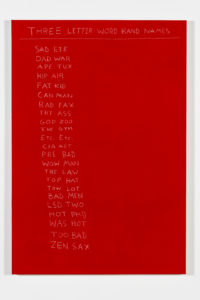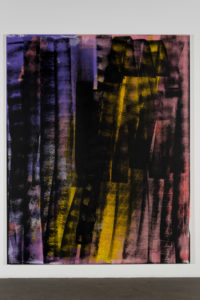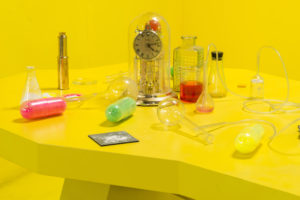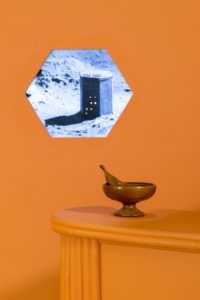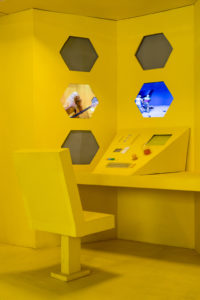Scott Reeder
- Scott Reeder interviewed by Laura Owens, February 2014
Conducted on the occasion of Scott Reeder’s solo exhibition at 356 Mission
Laura Owens: This project started last summer when we talked about your film Moon Dust, which you’ve been working on for almost nine years.
Scott Reeder: The movie is an ongoing thing that I work on when I have time, and so it goes to the back burner if I have painting exhibitions or other things like that to work on. I have to space it out so it doesn’t take over everything.
LO: Did you build the original set in your art studio?
SR: Yes, the original set was in the same building as my art studio, and at the same time I was making collaborative works with Donald Morgan. We had a wood shop in the front where I was making sculptures, including the robot sculptures that were shown at Pat Hearn. So there’s always been a cross-pollination between what’s going on with my paintings and sculptures and what’s going on with the film.
LO: Building the film set in the art studio actually mirrors the evolution of the show at 356. A year ago this was my art studio, since then I’ve envisioned handing it over to other artists to use as a studio or a place where they can make things. For you the studio has also been a film set. And at the same time the set is really reminiscent of your paintings, or made in a similar way to how decisions are made in your paintings.
SR: Yeah, I think that there’s a lot of overlap. There was a script to start the movie, but then once the production started, most of the script was thrown away. Dialogue and action would be written out in reaction to the space and the props and the objects. So the scenes are based on things, things in space. The movie naturally expanded in that direction. The original plot took place in one room, but as we became more ambitious, we built more rooms and adding more characters. The last scenes, which were shot here in L.A., are the most elaborate. I was able to make sets I’ve had in the back of my mind for years.
LO: People seeing the exhibition might not understand that the intention was to quickly finish a few scenes while also making paintings in the space and in my studio, as well as editing the film. You ended up continuing to build sets and shoot new footage while you were painting, and what might have been just a switch over to making a painting exhibition became a complex experiment in doing too much.
SR: There was a crazy blur between the painting production and the movie production. I don’t know if you even saw this, but for a lot of shoots we were using these big blank stretchers as bounces for the lights.
LO: The actual pre-painted blanks?
SR: It was a blank white canvas that had been stretched and primed. We also stretched a green screen fabric over a painting since we needed a flat surface. We shot a group of people in front of it and that painting went on to become a different painting.
LO: That’s amazing. So not only do the sets have an unseen functionality in the exhibition, but the paintings have an unseen functionality for the film. You were trying to develop a couple of new bodies of work for this show, one of which you got really excited about and ended up making ten or fifteen giant paintings. They started out as landlord paintings, these roller paintings applied with a stick and a house-painting roller, not unlike when one of the people helping with Moon Dust would be painting a set or a wall.
SR: It’s something I’ve always liked the look of, when graffiti is covered up. Any half-assed paint job where two related colors sit on top, like a wall with four different kinds of beiges. It’s like a landlord who is trying to do the minimum amount of effort. It’s about an immediacy to make something look semi-presentable, but remaining interested in what’s underneath and this idea. One corner of the room was three different sets throughout the course of the month and you’d see the edges where previous colors peaked through and it was beautiful just watching these walls get repainted. Also the size of the mark in that space, the roller mark seemed like the right size, it’s such a huge space even with the sets taking up a lot of the room.
LO: I was really impressed with the improvisatory nature of the film, with the way you would gather the actors together and start shooting with just a couple cues or lines. In the same way, with the roller paintings you’re really confident with not having that much information as to how it’s going to go but just taking a few colors and letting it be exactly what it is. Not trying to be illustrative with it, or fix it, or make it better. With the actors, it seemed like the same thing—the lack of control you wanted to have over those people was pretty noticeable.
SR: You have to be comfortable with chaos and maybe failure, that some of the stuff that people would do might not be usable, but to get to that thing that’s natural or strange. It would be impossible to write, and I guess it’s the same with the paintings, you just have to have this confidence or blind faith that something interesting will happen if you just keep putting down the layers or putting down the paint. I think the paintings I’m most interested in are enigmatic, they have some mystery. What came first? What came second? How did the artist decide it was done? How did they leave this decision or get rid of this other decision? It’s like the casting, not everyone that showed up is probably going to be in the movie but we have this faith that someone’s going to show up that’s going to be great. Like Ian Svenonius was great. Knowing that this is going to happen and there’s this energy happening and with this network of people, you’re going to get some good performances and you’re going to get some good people that just show up, come out of the woodwork just because you set this thing up. It’s like a flytrap or something. It’s going to catch something interesting. And now I’m just at the point where I’m going to weed out the best of all the stuff we caught here in L.A.
Laura Owens is an artist and one of the founders of 356 Mission
- Select ReviewsPast Press
-
Breakfast at 356 !
February 2, 2014


